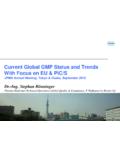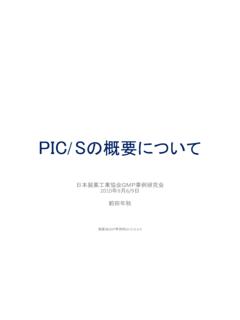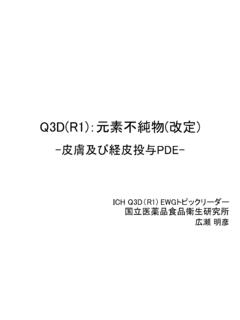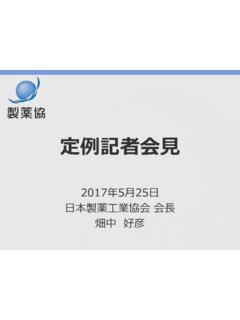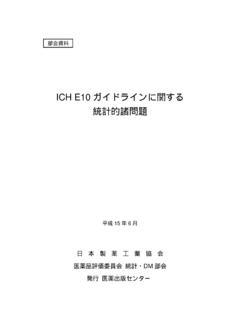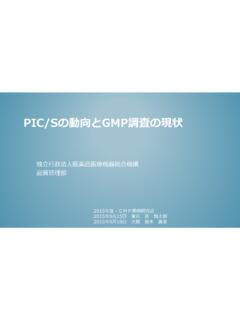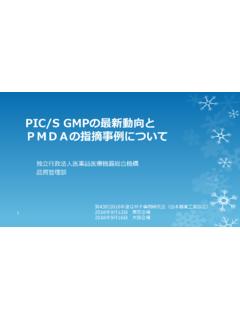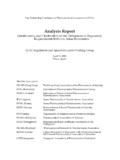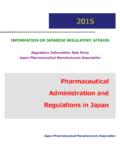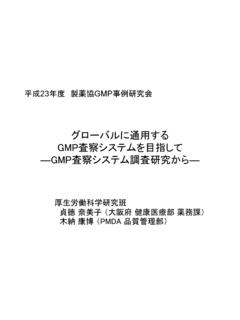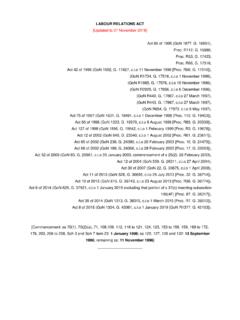Transcription of 1. PHARMACEUTICAL LAWS
1 PHARMACEUTICAL Regulations in Japan: that are especially essential for health care. CHAPTER 2. Modern PHARMACEUTICAL legislation originated in Japan with the enactment of the Regulations on PHARMACEUTICAL laws . Handling and Sales of Medicines in 1889. The AND REGULATIONS PHARMACEUTICAL Affairs Law was enacted in 1943 and was completely revised in 1948 and 1960 (Law No. 145). Subsequent revisions have included those related to reevaluation of new drugs after 1. PHARMACEUTICAL laws reexamination, notification of clinical study protocols, and items required for sponsoring clinical studies in PHARMACEUTICAL administration in Japan is based 1979, those related to direct manufacturing approval on various laws and regulations, consisting mainly of: applications by overseas PHARMACEUTICAL (1) PHARMACEUTICAL and Medical Device Act, (2) Law manufacturers, and the transfer of manufacturing or Concerning the Establishment for Pharmaceuticals import approvals in 1983, and those related to and Medical Devices Organization, (3) Law promotion of R&D of orphan drugs and priority Concerning Securing Stable Supply of Blood reviews for such drugs in 1993.
2 Products, (4) Poisonous and Deleterious Substances In 2002, the PHARMACEUTICAL Affairs Law (Law No. Control Law, (5) Narcotics and Psychotropics Control 96 dated July 31, 2002) was revised based on Law, (6) Cannabis Control Law, (7) Opium Law, and demands for augmentation of safety assurance in (8) Stimulants Control Law. keeping with the age of biotechnology and genomics, For the enforcement and management of these augmentation of post-marketing surveillance policies, laws , detailed regulations are prepared by the revisions of the approval and licensing system government in the form of ministerial ordinances and (clarification of the responsibility of companies for notices, such as the Enforcement Ordinance and the safety measures and revisions of the manufacturing Enforcement Regulations of the PHARMACEUTICAL and approval system in accordance with international Medical Device Act, and notifications issued by the coordination) and a radical revision of safety policies Director General of the Bureaus or the directors of the for medical devices.
3 According to the revised Law, Divisions in charge in the Ministry of Health, labour , the Provisions on the enhancement of safety and Welfare. measures for biological products came into effect on July 30, 2003 and the provisions related to the 2. PHARMACEUTICAL AND MEDICAL manufacturing/marketing approval system, DEVICE ACT manufacturing/marketing businesses, and manufacturing businesses, as well as the provisions The objectives of the PHARMACEUTICAL and Medical related to medical devices came into effect on April 1, Device Act are to improve public health through 2005. regulations required to assure quality, efficacy, and Thereafter, the Law for Partial amendment of the safety of drugs, quasi-drugs, cosmetics, medical PHARMACEUTICAL Affairs Law (Law No. 69 dated June devices, and regenerative medicine products and to 14, 2006) to revise the OTC drug selling system and prevent hazard and expansion of hazard in public strengthen the control of illegal drugs was issued in health caused by use of those products, as well as June 2006 and enforced on June 1, 2009 as planned.
4 Through measures required to promote R&D of drugs, The amended PHARMACEUTICAL Affairs Law has medical devices and regenerative medicine products classified non-prescription drugs according to 2020 - 15 - PHARMACEUTICAL Regulations in Japan: potential risks (type 1: especially high risk, type 2: Businesses, etc. of Medical relatively high risk, and type 3: relatively low risk) and Devices and in vitro Diagnostics the systems of information dissemination and Section 1 Manufacturing/Marketing consultation on drugs for each classification were Businesses of Medical Devices implemented. and in vitro Diagnostics (Article 23- In 2013, the Law for Partial amendment of the 2 to 23-2-22). PHARMACEUTICAL Affairs Law (Law No. 84 dated Section 2 Third-party Certification November 27, 2013) was issued for strengthening Bodies (Article 23-2-23 to 23-19). safety measures and for establishing regulations and Chapter 6: Manufacturing/Marketing control on medical devices and regenerative Businesses of Cellular and Tissue- medicine products in view of their properties and based Products (Article 23-20 to characteristics.)
5 The Law was enacted on November 23-42). 25, 2014. In conjunction with this law, the Law for Chapter 7: Retail Sellers, etc. of Drugs, Partial amendment of the PHARMACEUTICAL Affairs Law Medical Devices and Cellular and and the Pharmacists Law (Law No. 103 dated Tissue-based Products December 13, 2013) was issued in the same year for Section 1 Retail Sellers of drugs clarifying the Internet retailing rules of non-prescription (Articles 24 to 38). drugs and for tightening regulations on designated Section 2 Retail Sellers, Leasers drugs/substances. The Law was enacted on June and Repairers of Medical Devices 12, 2014 (provisions strengthening regulation of (Articles 39 to 40-4). designated substances were enacted on April 1, Section 3 Retail Sellers of Cellular 2014). and Tissue-based Products In the revised PHARMACEUTICAL Affairs Law enacted (Articles 40-5 to 40-7). on November 25, 2014, regulations on drugs, medical Chapter 8: Standards and Government devices and regenerative medicine products were Certification for Drugs (Article 41 to divided into individual chapters to restructure the Article 43).
6 Entire framework, as well as the PHARMACEUTICAL Chapter 9: Handling of Drugs Affairs Law was renamed to be the Law for Ensuring Section 1 Handling of Poisonous Quality, Efficacy, and Safety of Drugs and Medical and Deleterious Substances Devices (commonly-called the PHARMACEUTICAL and (Articles 44 to 48). Medical Device Act). Section 2 Handling of Drugs The revised Law, PHARMACEUTICAL and Medical (Articles 49 to 58). Device Act, consists of 17 chapters and 91 articles as Section 3 Handling of Quasi-drugs outlined below. (Articles 59 and 60). Chapter 1: General Provisions (Articles 1 to 2) Section 4 Handling of Cosmetics Chapter 2: Prefectural PHARMACEUTICAL Affairs (Articles 61 and 62). Councils (Article 3) Section 5 Handling of Medical Chapter 3: Pharmacies (Articles 4 to 11) Devices (Articles 63 to 65). Chapter 4: Manufacturing/Marketing Section 6 Handling of Cellular and Businesses of Drugs, Quasi-drugs Tissue-based Products (Articles and Cosmetics (Articles 12 to 23) 65-2 to 65-6).
7 Chapter 5: Manufacturing/Marketing Chapter 10: Advertising of Drugs, etc. (Articles 2020 - 16 - PHARMACEUTICAL Regulations in Japan: 66 to 68) materials, medical supplies, sanitary Chapter 11: Safety of Drugs, etc. (Articles 68- materials, and programs. 2 to 68-15) 3) Substances (other than quasi-drugs, Chapter 12: Special Handling of Biological cosmetics or regenerative medicine Products (Articles 68-16 to 68-25) products) which are intended to affect the Chapter 13: Supervision (Articles 69 to 76-3) structure or functions of the body of Chapter 14: Handling of Designated humans or animals, and which are not Substances (Articles 76-4 to 77) equipment or instruments. Chapter 15: Designation of orphan drugs, orphan medical devices and Classification of Drugs cellular and tissue-based orphan Drugs (medicinal products) ( iyakuhin in products (Articles 77-2 to 77-7). Japanese) can be classified as follows based on the Chapter 16: Miscellaneous Provisions (Article regulatory provisions in the PHARMACEUTICAL and 78 to 83-5).
8 Medical Device Act, etc. among others. Chapter 17: Penal Provisions (Article 83-6 to 91) 1) Classification according to use and supply (1) Pharmacy drugs (Article 4 in the Law). Drugs other than guidance- mandatory drugs 3. OUTLINE OF PHARMACEUTICAL . and non-prescription drugs. REGULATIONS. Includes prescription drugs Various regulations apply to the development, (drugs intended for use by a physician or dentist manufacture, import, marketing, and proper use of or under the prescription or instructions of a drugs and medical devices in the form of the physician or a dentist). PHARMACEUTICAL and Medical Device Act, cabinet (2) Guidance-mandatory drugs (Article 4 in the orders, MHLW ordinances, etc. An outline of the Law). main regulations affecting pharmaceuticals is Guidance-mandatory drugs are designated presented here. by the MHLW as drugs which clinical effects are not as significant as prescription drugs and Definition of Drugs intended to be selected and used by the consumer based on information provided by the Drugs subject to the regulations in the pharmacist, etc.
9 And must be sold via face-to- PHARMACEUTICAL and Medical Device Act are defined face consultation with a pharmacist. as follows in Article 2, Paragraph 1 of the Law. Deleterious substances and early switch OTC. The term "drugs" refers to the following substances . products are applicable. This is a new 1) Substances listed in the Japanese classification created in amendment of the Pharmacopoeia. PHARMACEUTICAL Affairs Law enacted on June 12, 2) Substances (other than quasi-drugs and 2014 (Law No. 103 dated December 13, 2013). regenerative medicine products), which are (3) Non-prescription drugs (Article 4 in the Law). intended for use in the diagnosis, Non-prescription drugs are defined as those treatment, or prevention of disease in in which clinical effects are not as significant as in humans or animals, and which are not prescription drugs and which a consumer may equipment or instruments, including dental select and use based on information provided by 2020 - 17 - PHARMACEUTICAL Regulations in Japan: a pharmacist, etc.
10 Those are neither pharmacy of infection as specified in Notification No. 0731011. drugs nor guidance-mandatory drugs. Those are of the PMSB dated July 31, 2002, from the classified into three types based on the degree of standpoint of augmentation of safety measures in risks to humans: Type 1 (highly risky), Type 2 keeping with advances in science and technology (moderately risky) and Type 3 (relatively low including biotechnology and genomics. risky). In the revised PHARMACEUTICAL Affairs (1) Biological products Law enacted on June 12, 2014, non-prescription Drugs, quasi-drugs, cosmetics, or medical drugs may be retailed via the Internet in devices using materials manufactured from accordance with the proper rule. humans or other organisms (excluding plants). 2) Classification according to handling as raw materials or packaging materials, which regulations related to safety are designated as requiring special Drugs include those that are highly poisonous, precautions in terms of public health and which have serious adverse reactions and which hygiene.
